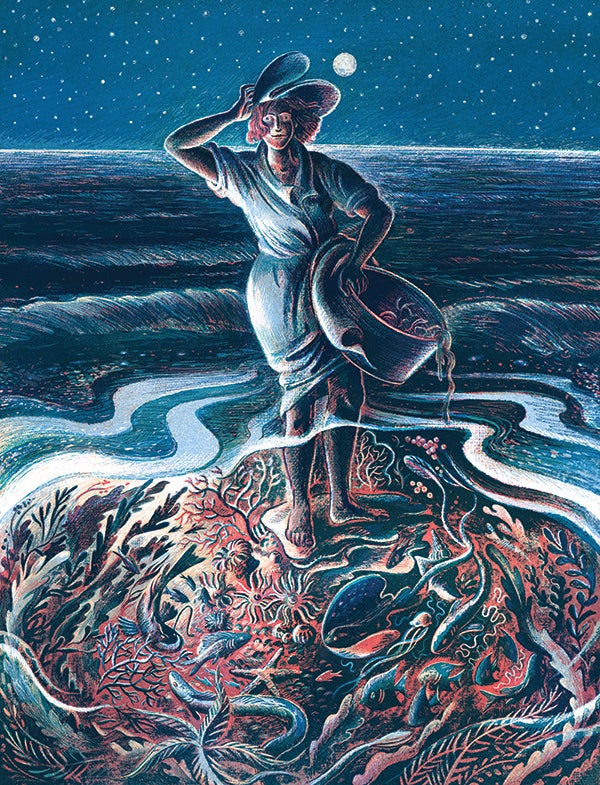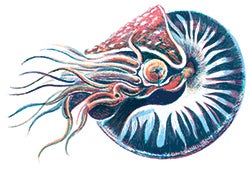Environmental Awakening
Rachel Carson is at the heart of Douglas Brinkley’s new book documenting the rise of environmentalism.

Summer 2023
Illustrations by Wesley Allsbrook
Douglas Brinkley is impressive in any number of ways. For one, CNN states that he knows more about the American presidency than anyone else alive. For another, seven honorary doctorates may be more than any one person is entitled to. And for a randomly selected third, he’s won a Grammy for co-producing a jazz album. But he is also a remarkably prolific writer, authoring or co-authoring nearly 30 books of history, many of which tend to be heavy tomes. His latest, with the appropriately lengthy title “Silent Spring Revolution: John F. Kennedy, Rachel Carson, Lyndon Johnson, Richard Nixon, and the Great Environmental Awakening,” comes in at over 800 pages.
Notably, while “Silent Spring Revolution” is organized around entire sections devoted to the other titular figures, biologist and ecologist Rachel Carson could not be constrained to a single section; instead, her name appears in five chapter titles throughout the book, reflecting her continued significance across four decades of environmental awakening. Carson’s role in bringing much-needed attention to ecological concerns with her beautifully poetic and yet scientifically unerring prose cannot be overstated.
Indeed, Brinkley’s book title is a reference to Carson’s most impactful book, “Silent Spring,” which explained in 1962 how the pesticide DDT entered the food chain and led to cancer and genetic damage in animals, including humans. Her book resulted in the banning of DDT and in a new understanding that industry had to be regulated in order to protect our fragile world.
— Hilary C. Ritz
The following is an excerpt from Chapter 3: “Rachel Carson and the Shore of the Sea,” of Brinkley’s book.
Just twenty-five miles west of Hyannis Port, where the Kennedys and thousands of other families enjoyed the sail-dotted water along the coast, the Woods Hole Oceanographic Institution was home to those fascinated with the world beneath the ocean surface. Established in 1930, Woods Hole operated beside the previously existing Marine Biological Laboratory and the Woods Hole Laboratory of the US Commission of Fish and Fisheries. Rachel Carson, who worked as an ocean science researcher at all three over the years, considered the coastal village of Woods Hole the most “delightful place” to “biologize.”
During the summer of 1929, the trim and proper twenty-two-year-old Carson was on a research fellowship at the MBL and living in a cottage run by the lab. Down a path from her quarters was the marvelous Nobska Point Light Station. On a clear day, she would sit there and gaze toward the vacation island of Martha’s Vineyard, watching sea ducks bob and collecting spine-studded urchins at the low-tide line. Migrating eels and bottom-dwelling mollusks became her primary interests that summer and later. Though Carson had never seen the ocean until that summer, she had read about the diverse animal societies to be found on shorelines. Chatting with conchologists or ichthyologists at the MBL was a thrill for the budding zoologist. Carson enthused that it “would be very easy to acquire the habit of coming back every summer” at Woods Hole, conducting marine experiments in the huge redbrick Crane Laboratory building and diving into books at the extensive oceanographic library. But those weren’t the only attractions. “To understand the shore, it is not enough to catalogue its life,” she wrote. “Understanding comes only when standing on a beach, we can sense the long rhythms of earth and sea that sculptured its landforms and produced the rock and sand of which it is composed; when we can sense with the eye and ear of the mind the surge of life beating always at its shores—blindly, inexorably pressing for a foothold.”

That summer Carson began a study of the cranial nerve in reptiles. If serious research at the MBL set her course professionally, long walks on the sand and swims in the waves gave her a life-affirming love of the sea. The two strains of Carson’s Woods Hole stint combined with her own inborn view of the world. To her, all of God’s creatures had a will to live and were worthy of compassion. Though not outwardly philosophical, she did believe that every person had to respectfully repay an eternal debt to nature. At a young age, she understood ecology as a basic notion: We live in the house of life, and all the rooms connect. A line by the English poet Francis Thompson nicely summed up her view: “Thou canst not stir a flower / Without troubling of a star.”
... As a “beginning investigator” of the Atlantic Ocean, [Carson] entered graduate school in zoology at Johns Hopkins University in Baltimore on a one-year scholarship. Whenever possible, she worked to improve the flow and rhythm of her prose. After earning her master’s degree in 1932, she wrote articles about the Chesapeake Bay for the Baltimore Sun, focusing on mid-Atlantic fish and wildlife under headlines such as “It’ll Be Shad Time Soon” and “Chesapeake Eels Seek the Sargasso Sea.” Her Sun articles showcased her broad interest in progressive conservation writ large. However, freelancing for the newspaper, though satisfying, didn’t earn her much money to live on.
After Carson’s father, Robert, died in 1935, she taught part-time at the University of Maryland and Johns Hopkins summer school. With him gone, there was little income with which to support her mother and herself. When Professor Skinker learned that Rachel was in a financial bind, she recommended applying to the Bureau of Fisheries in Washington, DC, which had recently undertaken a series of radio broadcasts entitled Romance Under the Sun. It needed a part-time biologist-type who could write. Carson recalled later, “I happened in one morning, when the chief of the biology division [Elmer Higgins] was feeling rather desperate—I think at that point he was having to write the scripts himself. He talked to me a few minutes and then said: ‘I’ve never seen a written word of yours, but I’m going to take a sporting chance.’ That little job, which eventually led to a permanent appointment as a biologist, was in its way, a turning point.” She was hired as a junior aquatic biologist in the Division of Scientific Inquiry, writing radio scripts about fish.
For the rest of Carson’s life, her main fascination was discovering the exotic creatures who lived in saltwater ecosystems, especially crustaceans, seaweeds, invertebrates, and small fish—what one of her biographers, William Souder, called ‘an embassy of living things.’
At about the same time, Carson had a turning point in her freelance writing career, as well, when Atlantic Monthly published her “Undersea” essay in its September 1937 issue. In it, she brilliantly explored tidal pools, surface waters, and the seafloor, treating humans as aliens and predators, at a remove from the ocean ecosystem. Only by thinking like a sea creature, she felt, could a scientist fully grasp the marine environment. “Who has known the ocean?” she wrote. “Neither you nor I, with our earth-bound senses, know the foam and surge of the tide that beats over the crab hiding under the seaweed of his tide-pool home; or the lilt of the long, slow swells of mid-ocean, where shoals of wandering fish prey and are preyed upon, and the dolphin breaks the waves to breathe the upper atmosphere.”
... In 1938, bolstered by positive feedback from the Atlantic essay, Carson spent another summer at Woods Hole gathering material for her first book. She also went on a working vacation at a Bureau of Fisheries station in Beaufort, North Carolina. The sandpits and tidal marshes along the mid-Atlantic Coast, protected by the Outer Banks of barrier islands, provided her with rich material for her project, which would become Under the Sea-Wind. Her adoption of sea creatures such as Scomber, the primary character in Under the Sea-Wind, resembled Henry Williamson’s treatment of otters in his book, Tarka the Otter (1927), while the musicality of her prose was reminiscent of Beston’s The Outermost House. For the rest of Carson’s life, her main fascination was discovering the exotic creatures who lived in saltwater ecosystems, especially crustaceans, seaweeds, invertebrates, and small fish—what one of her biographers, William Souder, called “an embassy of living things.”
Under the Sea-Wind, her first and favorite book, was published in November 1941 by Simon & Schuster. Its artwork was by Howard Frech, an illustrator Carson had worked with in Baltimore. Under the Sea-Wind was a masterly dissertation on the life cycles of three ocean creatures, told from the perspective of the animals themselves. The first section, “Edge of the Sea,” was about the migratory journey of the sanderling pair Silverbar and Blackfoot from the Outer Banks of North Carolina to the Arctic Circle and back to Patagonia. “The Gull’s Way,” the second part, centered on Scomber the mackerel, swimming through a gauntlet of near-death experiences from the shores of New England to the Continental Shelf. Finally, “River and Sea” depicted migration as experienced by Anguilla the eel, who journeyed to the Sargasso Sea, south of Bermuda, a spawning ground for American and European eels. All three migration stories were based on the latest research on the life cycles of sea creatures. Carson had anthropomorphized the sanderling, mackerel, and eel to help the reading public see the world through their underwater eyes and so absorb their dramatic survival stories in a more sincere way.
In the preface, Carson, praising Beston’s The Outermost House, admitted to being awestruck by that Cape Cod memoir’s great simplicity, beauty, and reflection of oceanic rhythms. With Beston pointing the way, she vowed “to make the sea and its life as vivid a reality for those who may read the book as it has become for me during the past decade.”
About a dozen years later, in the mid-1950s, John F. Kennedy received a copy of Under the Sea-Wind as a gift from his mother. Although Under the Sea-Wind sold in low numbers, perhaps because Pearl Harbor occurred right after it debuted, it became celebrated by marine biologists and other lovers of the animal kingdom.
Seldom had a scientifically accurate delineation of ocean species been written with such gorgeous literary flair. At the time it was published, glowing reviews poured in; the New York Times called it a “beautiful and unusual” book for a naturalist. William Beebe, who had ventured three thousand feet deep in a record-breaking descent in the Bathysphere off the coast of Bermuda, authoritatively declared in the Saturday Review of Literature that he couldn’t detect a single error in Under the Sea-Wind. In a 1945 anthology that Beebe edited, The Book of Naturalists: An Anthology of the Best Natural History, an essay by Carson appeared alongside work by such immortals as John James Audubon and Henry David Thoreau. Pleased to be recognized as a defender of the world’s oceans and sea life, Carson professed that her ambition was to leave the natural world “a better place to live in.”
Adapted from “Silent Spring Revolution: John F. Kennedy, Rachel Carson, Lyndon Johnson, Richard Nixon, and the Great Environmental Awakening” (Harper Collins, 2022) and used by permission of the author.
